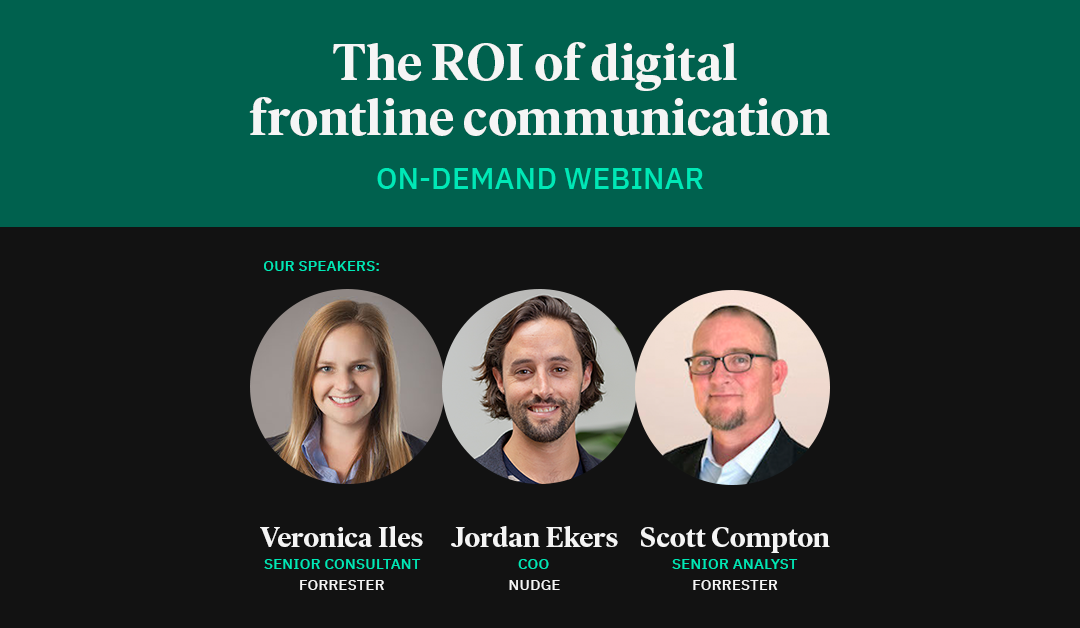
3 takeaways from our on-demand webinar, The ROI of digital frontline communication
We’re in uncharted territory as we navigate out of the pandemic into a new world. The demands on frontline and deskless organizations have changed – and these workers need support like never before. And that support starts with the technology that enables organizations to share real-time info and collect in-the-moment feedback to move quickly and stay agile in any situation.
To explore the ROI of digital frontline communication, we recently hosted a webinar featuring special guests from Forrester. Guest speaker Forrester Senior Consultant Veronica Iles walked attendees through Nudge’s recently commissioned Total Economic Impact™ Study, conducted by Forrester Consulting, which included a three-year ROI of 484%. Then, Nudge COO Jordan Ekers and guest speaker, Forrester Senior Analyst of Digital Commerce, Scott Compton, discussed the trending challenges facing the frontline, and the role that technology can play in bringing these organizations into the “new normal.”
The webinar is now available for on-demand viewing, but in the meantime, here are our top 3 takeaways from The ROI of Digital Frontline Communication:
1. The labor crisis is far from over – but the drivers behind it might be different than you’d think
“The US labor participation rate is at its lowest point that we’ve seen since the mid 1970’s when women joined the workforce en masse,” explains guest speaker Scott Compton, Forrester’s Senior Analyst of Digital Commerce. “Deskless workers are having a harder time deciding to go back to that job. Potentially they’ve shifted to other lines of work while things were shut down. And whatever it was bringing them there before isn’t as compelling.”
But the labor crisis facing frontline and deskless organizations isn’t just about a shift from workers. Compton also noted that the demands consumers are placing on retailers have also added to a strain on the workforce. “Store associates are actually having to do more on the floor than they ever were before. And then through cleaning and other regiments like that on top of it,” he explains.
One additional angle Compton noted was impacting the labor crisis is pressure from consumers about how organizations treat their labor. “About 47 percent or so of consumers think brands should take a stand on minimum wage and roughly 37 percent say that fair wages help them determine where to shop,” said Compton. “So basically if you’re not taking care of your employees, your customers are eventually going to know about it and decide to shop somewhere else. So there are a ton of basic pressures on retailers right now.”
2. There’s been a post-COVID “major flush in communication tools,” but not all tools are created equal
When COVID hit, Compton explained, one of the first areas that really broke for frontline and deskless organizations was communication. “A feedback loop on those communication paths became very, very critical as doors were deciding basically to continue to stay open and what they needed to keep serving the customer,” he explained.
However, not all communication tools are created equal. “Just because you can send an SMS message or an email or a push message, whatever it might be, does not mean that you have a platform that’s enabled to do the real work related to communications and getting in front of those frontline employees.”
In other words: just because you have a method to share information doesn’t mean it’s the right one. “We have a stat that millennials and Gen Z workers will be 74% of the workforce by 2030,” says Compton. “And these folks have grown up digitally native, if not adopted them very early in their lives. And they have different expectations about the way that they want to interact with their tool sets at work. And we need to be evolving with them.”
3. To optimize the customer experience, focus on knowledge and information (through the right tech)
“So a little perspective on the US consumer right now,” Compton explains. “Roughly a third are increasing the frequency and the duration of their store visits – so not only are we going back into stores, but we’re staying longer, which is also a good sign. But roughly half the consumers are noticing that the stores seem under-staffed or they find it difficult to find associates.”
And that’s a problem, because according to Compton, the whole reason that consumers are going back in-store is to get answers directly. “There’s still the consumer need to interact with a human being in the store environment, especially with real knowledge about the product and its use, and local trends. So there’s still a lot to be said for that specific location being a very strong brand presence. Even taking the transaction pieces away.”
Having the right communication tools in place can play a pivotal role in arming associates with the information they need to deliver on the in-store experience, especially considering that with the line between in-store and digital getting blurred, consumers are coming into stores with more information than ever before. “Consumers want ease and efficiency. They know the information is out there in terms of product data, and they expect those store associates to at least have the tool sets that they have in their hands when they come in the front door.”
—
Watch the full on-demand webinar here for more insights from Jordan Ekers and Scott Compton, plus a full review of Nudge’s recently commissioned Total Economic Impact™ Study, conducted by Forrester Consulting, with guest speaker, Forrester Senior Consultant Veronica Iles.




